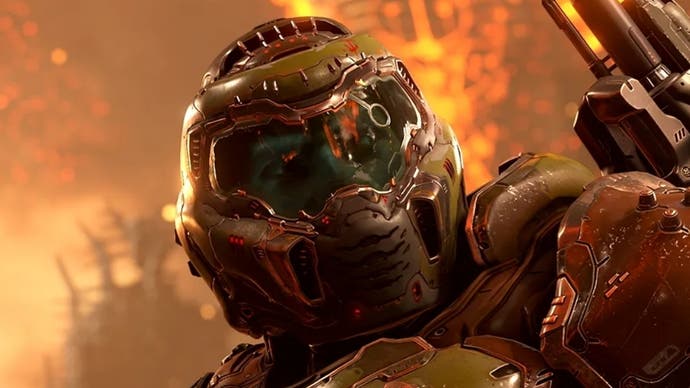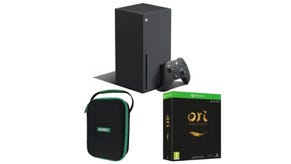Doom Eternal's next-gen patch tested on PS5 and Xbox Series consoles
Ray tracing, 120Hz support - and even more impressive visuals.
Released at the tail-end of last week, Doom Eternal's upgrade for PC and next generation consoles is an important release - it's our first chance to see how the tech masterminds at id Software are choosing to approach the new features of the latest hardware. Ray tracing, in the form of accurate, real-time reflections, is key to the upgrade, but in putting the new consoles through their paces, a trio of modes are available - and we've tested all of them on PS5, Xbox Series X and Series S.
We'll go into the specifics shortly, but putting this latest update into context, it's just part of a series of patches and upgrades that have served to further evolve a game that was already brilliant at launch. Two additional DLC packs have provided excellent extra content - rare for a single-player game - along with extra features and tweaks. id isn't done either, as it looks like a horde mode is also arriving for the game at some point too.
But returning to the next-gen upgrades, we've already looked in-depth at the PC version of the game with a particular focus on the real-time reflections id software has added to the game's aesthetic, dramatically improving upon the standard cube maps and screen-space reflections the game has had since launch. There's a dramatic level of scalability in the implementation - which goes far beyond the 'baked in' presets - and that's accessible via the command line. On PlayStation 5 and Series X, the same RT features are in place and they are effectively on par with the PC's medium RT quality level, with reflections rendered at one third the current resolution.
Elsewhere, expect settings broadly on par with the PC version at ultra, but for some reason, anisotropic filtering seems to be disabled on all consoles, diminishing image quality on textures observed from oblique angles. Dynamic resolution scaling is also in effect, with a top ceiling of 3200x1800, while drops to around 70 percent on both axes are observed, with the absolute minimum set to 50 percent. There's the sense that something is missing here, that the image isn't quite as sharp as it could be and that applies to both consoles. In terms of pixel counts, Series X does seem to resolve higher numbers in stress points compared to PlayStation 5. Meanwhile, Xbox Series S has no RT support at all. Bearing in mind how scalable the game is across the board, its absence is disappointing.
Next up, there's the 120Hz mode, which works best on HDMI 2.1 displays, allowing for the game's full resolution to successfully resolve at full frame-rate. This looks to offer something akin to the last-gen Doom Eternal experience at twice the performance level. Xbox Series X operates at a dynamic 1800p, while PlayStation 5 tops out at 1584p - and it is visibly blurrier. Finally, Series S aims to deliver 120 frames per second at a maximum of 1080p, though drops to 70 percent on both axes is possible, which is a touch higher than 720p.
Finally, id delivers a balanced mode, which retains the ultra settings but turns off ray tracing, deploying the freed up GPU resources on increased resolution: 4K on PS5 and Xbox Series X, and 1440p on Series S. There's little we can say about this mode except to note that while DRS is present, it's mostly as a fallback measure. To our eyes, the game simply rolls out at a locked 60 frames from start to finish and of all the modes available, this provides the sharpest image.
We've not talked about performance yet because fundamentally, the story is rather uninteresting - in a good way! In almost all scenarios, Doom Eternal hits its 60fps and 120fps targets. We've seen some titles struggle with high frame-rate modes but in a world where a £150 Core i5 can run Doom Eternal on PC at upwards of 300fps, a mere 120fps seems like a walk in the park for the CPUs in the new consoles. Meanwhile, the excellent GPU scalability found in idTech 7 takes care of everything else, giving you a rock-solid lock to 60fps or 120fps in all relevant modes on all consoles. The only noticeable exception is checkpoint stutter - where the game momentarily pauses for a split-second to auto-save your progress.
Now, we can't test the entire game, of course, but we did give the first half of the game a decent workout on all three consoles in all available modes. The only actual drop we could find was in the Arc Complex and making the game dip from its frame-rate target involves being in a certain area, looking in one specific direction and firing a bunch of rockets. In this very select series of conditions, all three consoles were affected, with Series S affected most and Series X affected least. However, this is very much the exception that proves the rule - this game is super-fast and smooth overall and it's beautifully optimised.
It's also interesting to note that Xbox Series consoles use the hardware-based tier two VRS feature of the RDNA2 hardware, which is not present on PlayStation 5. VRS stands for variable rate shading, adjusting the precision of pixel shading based on factors such as contrast and motion. Pre-launch there was plenty of discussion about whether PS5 had the feature or not and the truth is, it doesn't have any hardware-based VRS support at all. However, developers can tap into the MSAA anti-aliasing hardware and exploit it to deliver something very similar to a tier one VRS solution. Metro Exodus does this on PlayStation 5, while Call of Duty Warzone does something similar on all consoles. In combination with Series X's extra GPU grunt, the use of variable rate shading may explain why the Microsoft console achieves higher resolutions overall.
Ultimately though, this is an excellent upgrade for all three consoles - the cherry on top for what is one of my favourite games of last year. Criticisms are few and far between - the only negative aspect for me was the next-gen upgrade procedure on PlayStation 5. Initially it did not work. And when it did work, I discovered that none of my saves from PlayStation 4 could be transferred across. Meanwhile, everything just worked on the Series machines, I could pick up where I left off with no problem. Like it or not, cross-gen is a part of the experience and things do need to be smoother and more seamless on PS5. Other than that though, there's little to take issue with. A brilliant game just got better. It looks and plays beautifully on the new wave of console hardware.












